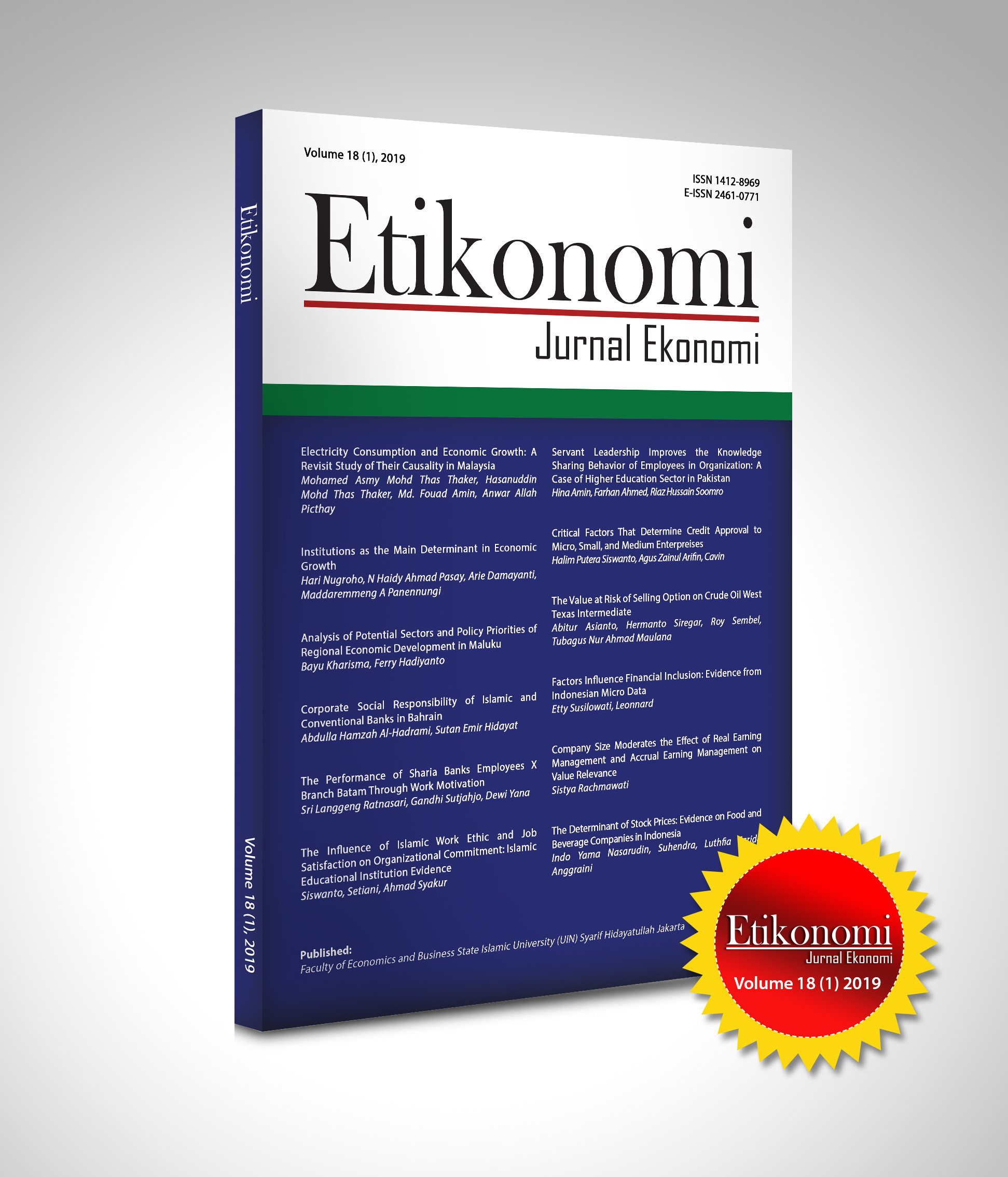Institutions as the Main Determinant in Economic Growth
DOI:
https://doi.org/10.15408/etk.v18i1.8242Keywords:
institutions, human capital, technological progress, economic growthAbstract
The studies on human capital and technological progress have given incredible insights on how countries in the world differ from one another. Yet there are more than those two reasons to account for differences among countries. There is a third reason why a country would differ in terms of its economic development progress, namely institutional factors. Hence developing institutional indices would give a deeper explanation than a mere theory. On the other hand, we can corroborate the institutional index with the general theory that low-quality institutions will impact an economy negatively. This study seeks to broaden the understanding of causes of economic growth by incorporating institutional index into a semi-endogenous growth model and finds a relationship between that index with human capital and technological progress.
JEL Classification: E01, E02, O43
Downloads
References
Acemoglu, D., Aghion, P., & Violante, G. L. (2001). Deunionization, Technical Change and Inequality. Carnegie-Rochester Conference Series on Public Policy, 55(1), 229–264. https://doi.org/10.1016/S0167-2231(01)00058-6
Acemoglu, D., & Robinson, J. A. (2008). Persistence of Power, Elites, and Institutions. American Economic Review, 98(1), 267–293.
Ahmad, M., & Hall, S. G. (2017). Economic Growth and Convergence: Do Institutional Proximity and Spillovers Matter? Journal of Policy Modelling, 39(6), 1065–1085. https://doi.org/10.1016/j.jpolmod.2017.07.001
Arellano, M., & Bond, S. (1991). Some Test of Specification for Panel Data: Monte Carl Evidence and An Application to Employment Equations. The Review of Economic Studies, 58, 277–297.
Filmer, D., & Pritchett, L. H. (2001). Estimating Wealth Effects without Expenditure Data or Tears: An Application to Educational Enrollment in States of India. Demography, 38(1), 115–132.
Gallup, J. L., Sachs, J. D., & Mellinger, A. D. (1999). Geography and Economic Development. International Regional Science Review, 22(2), 179–232.
Grossman, G. M., & Helpman, E. (1991). Innovation and Growth in the Global Economy. Cambridge: MIT Press.
Hall, R. E., & Jones, C. I. (1999). Why Do Some Countries Produce So Much More Output Per Worker Than Others? The Quarterly Journal of Economics, 114(1), 83–116.
Islam, N. (1995). Growth Empirics: A Panel Data Approach. The Quarterly Journal of Economics, 110(4), 1127–1170.
Jellema, J., & Roland, G. (2011). Institutional Clusters And Economic Performance. Journal of Economic Behavior and Organization, 79(1–2), 108–132. https://doi.org/10.1016/j.jebo.2011.04.003
Jones, C. I. (1995a). R & D Based Models of Economic Growth. Journal of Political Economy, 103, 759–784.
Jones, C. I. (1995b). Time Series Tests of Endogenous Growth Model. Quarterly Journal of Economics, 110, 495–525.
Jones, C. I. (2002). Sources of U.S. Economic Growth in a World of Ideas. American Economic Review, 92, 220–239.
Kandil, M. (2009). Determinants of Institutional Quality and Their Impact on Economic Growth in the MENA Region. International Journal of Development Issues, 8(2), 134–167. https://doi.org/10.1108/14468950910997
Knack, S., & Keefer, P. (1995). Institutions and Economic Performance: Cross-Country Tests Using Alternative Measures. Economics and Politics, 7(3), 207–228. https://doi.org/10.1111/j.1468-0343.1995.tb00111.x.
Lin, Y., & Chen, X. (2011). Review of Institutions and Economic Growth Empirical Research. In Q. Zhou (Ed.), Applied Economics, Business and Development. Berlin: Springer.
Lucas Jr, R. E. (1988). On the Mechanics of Economic Development. Journal of Monetary Economics, 22(1), 3–42. https://doi.org/10.1016/0304-3932(88)90168-7
North, D. C. (1991). Institutions. Journal of Economic Perspectives, 5(1), 97–112. https://doi.org/10.1257/jep.5.1.97
Nugroho, H. (2018). Peran Institusi dalam Model Pertumbuhan Semi-Endogen (The Role of Institutions on Semi-Endogenous Growth Model). (Unpublished Dissteration). Depok: Universitas Indonesia.
Osman, R. H., Alexiou, C., & Tsaliki, P. (2011). The Role of Institutions in Economic Development: Evidence from 27 Sub‐Saharan African Countries. International Journal of Social Economics, 39(1–2), 142–160. https://doi.org/10.1108/03068291211188910
Rachdi, H., Hakimi, A., & Hamdi, H. (2018). Liberalization, Crisis, and Growth in MENA Region: Do Institutions Matter? Journal of Policy Modelling, 40(4), 810–826. https://doi.org/10.1016/j.jpolmod.2018.05.001
Romer, P. M. (1986). Increasing Returns and Long-Run Growth. Journal of Political Economy, 94(5), 1002–1037.
Romer, P. M. (1990). Endogenous Technological Change. Journal of Political Economy, 98(5), S71–S102.
Roy, B. C., Sarker, S., Mandal, N. R., & Pandey, S. K. (2014). Role of Institutions in Economic Performance: An Empirical Study on Interstate Differences in Indian States with Reference to Jharkhand. European Scientific Journal, 10(10), 313–335.
Sachs, J. D. (2001). Tropical Underdevelopment. NBER Working Paper No. 8119.
Segerstrom, P. S. (1998). Endogenous Growth without Scale Effects. American Economic Review, 88, 1290–1310.
Siddiqui, D. A., & Ahmed, Q. M. (2013). The Effect of Institutions on Economic Growth: a Global Analysis Based on GMM Dynamic Panel Estimation. Structural Change and Economic Dynamics, 24, 18–33. https://doi.org/10.1016/j.strueco.2012.12.001
Slesman, L., Baharumshah, A. Z., & Raees, W. (2015). Institutional Infrastructure and Economic Growth in Member Countries of the Organization of Islamic Cooperation (OIC). Economic Modelling, 51, 214–226. https://doi.org/10.1016/j.econmod.2015.08.008
Solow, R. M. (1956). A Contribution to the Theory of Economic Growth. The Quarterly Journal of Economics, 70(1), 65–94.
Sumanjeet. (2015). Institutions, Transparency, and Economic Growth. Emerging Economy Studies, 1(2), 188–210. https://doi.org/10.1177/2394901515599272
Yildirim, A., & Golkap, M. F. (2016). Institutions and Economic Performance: A Review on the Developing Countries. Procedia Economics and Finance, 38, 347–359. https://doi.org/10.1016/S2212-5671(16)30207-6










